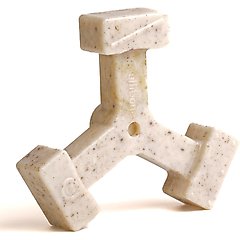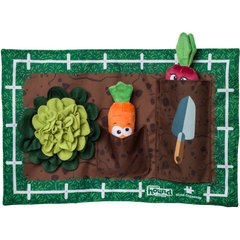How To Stop Territorial Aggression in Dogs

Photo by primeimages/E+ via Getty Images
If your pup goes into full security guard mode every time the mail carrier shows up, you might be dealing with territorial aggression. While it’s normal for a dog to be alert when someone approaches their home turf, actual territorial aggression in dogs can cross the line, turning everyday encounters into stressful—and sometimes dangerous—situations.
Understanding why this behavior happens is the first step toward addressing it safely. Here’s what territorial aggression looks like, what causes it, and what you can do about it.
Key Takeaways
- Territorial aggression is when a dog reacts aggressively toward people or animals approaching their perceived territory. They may be friendly in other environments, though.
- Causes can be genetic, learned, or environmental, and may include protective instincts, breed tendencies, lack of early socialization, and/or negative past experiences.
- Targeted training and counterconditioning are among the most effective solutions, ideally with guidance from a qualified trainer or behaviorist.
What Is Territorial Aggression in Dogs?
Territorial aggression is when a dog exhibits aggressive behavior toward other people or dogs who come near the dog’s perceived territory. The territory can be large (encompassing the whole neighborhood) or small (limited to the house, yard, or even a car), according to Adrienne Carson, CPDT-KA, CDBC, a certified dog trainer at St. Hubert’s Animal Welfare Center in Madison, New Jersey.
This behavior is limited to specific areas where your dog thinks they’re in charge. In different locations, your dog might be very friendly toward people and other dogs, says Wailani Sung, DVM, DACVB, FFCP, board-certified veterinary behaviorist at Joybound People & Pets in Walnut Creek, California.
On the other hand, general aggression isn’t location-specific and can happen anywhere. Research shows that dogs with general aggression may also exhibit those behaviors toward family members, while dogs with territorial aggression typically don’t.
What Does Territorial Aggression in Dogs Look Like?
Territorial aggression in dogs can manifest in various ways, ranging from subtle body language cues to intense, overt reactions. Like non-territorial aggression, the behavior doesn’t always escalate to biting or an attack, but it can.
Common signs of territorial aggression include:
- Barking
- Growling
- Lunging or charging
- Snapping or biting
- Blocking or herding
- Raised hackles (the fur along the back standing up)
- Stiff, tense body posture
- Staring at the trigger
- Pacing or restlessness
What Causes Territorial Aggression in Dogs?
Dr. Sung says territorial aggression in dogs can be caused by genetics or learned factors. While the exact cause varies from dog to dog, these are some of the most common:
- Protective instincts: Thanks to their wild ancestors, dogs are naturally wired to protect their resources, which can include people and spaces.
- Lack of early socialization: Dogs who weren’t exposed to a variety of people, animals, and environments during their critical socialization period (3–14 weeks old) are more likely to perceive strangers as threats later in life.
- Negative past experiences: A dog who has previously been hurt or scared in their own territory (even just once) may become hypervigilant and defensive.
- Breed tendencies: Dr. Sung says some dogs have been bred for protection and are more prone to territorial behaviors. These breeds include Akitas, Boxers, Saint Bernards, and other breeds in the AKC Working Group.
- Lack of training or boundaries: Without consistent guidance, dogs may believe it’s their job to decide who can enter a space, leading to excessive guarding behaviors.
- Fear and anxiety: For some dogs, territorial aggression stems from fear more than dominance. They act aggressively to drive away what scares them before it can come closer.
How To Stop Territorial Aggression in Dogs
Territorial aggression can be stressful for you and your dog, but with patience and consistency, you can help them feel more secure and often reduce the behavior over time. Here are some ways you may be able to stop territorial aggression:
Manage Their Environment
Managing your dog’s environment may help ease their anxiety and shift their focus away from the perceived threat.
Of course, you don’t want to let anyone sneak up on your dog, but you can try to redirect their attention by:
- Blocking their view with curtains or fencing.
- Using pet gates, like this playpen from Unipaws, to keep them away from high-traffic windows or doors.
Recommended Product
- Giving them a toy or chew, like the Bullibone Spin, to keep their mouth busy instead of barking.
Recommended Product
- Tossing a ball, like Frisco Colorful Tennis Balls, for them so they can focus on chasing instead of guarding.
Recommended Product
Also, make sure your dog feels secure in their home. Don’t let people or other animals repeatedly encroach on your dog’s space. Carson says to encourage your dog to leave the space and engage instead.
Reward Them for Good Behavior
When your dog stays calm in a normally triggering situation, Dr. Sung says you should reward them with dog treats, praise, or play. Over time, they’ll start to associate the presence of strangers with positive outcomes instead of threats.
- Keep high-value treats, like the Victor Hi-Pro Bites, handy for these moments.
Recommended Product
- Reward calm body language, like a wagging tail and soft eyes.
- Be consistent—every calm response should get some form of reward.
Desensitization and Counterconditioning (DSCC)
Dr. Sung also relies on desensitization and counterconditioning (DSCC) to curb territorial aggression.
In the desensitization phase, your dog is gradually exposed to triggers, such as a person, at a distance where they don’t exhibit aggressive behavior.
Counterconditioning builds on this by pairing the trigger with something your dog loves, like treats or praise. This pairing helps them associate the “threat” with a positive experience.
During this process, the person steps closer while the dog continues to get rewards for not getting upset. While it can be slow, it’s effective.
That said, you should only let a trainer or behaviorist countercondition your dog to keep them safe. You can find one near you through the International Association of Animal Behavior Consultants (IAABC) directory.
Provide More Physical and Mental Stimulation
Excess energy can exacerbate territorial behavior. Make sure your dog gets enough exercise and mental engagement each day to help lower reactivity.
- Go for long, structured walks.
- Try puzzle feeders, like the Outward Hound Puzzle Game, or activity mats, like the Outward Hound Garden Game.
Recommended Products
- Rotate dog toys to keep things interesting.
How Do I Prevent Territorial Aggression in My Dog?
While some territorial instincts are natural, you can take proactive steps, such as early socialization, setting consistent boundaries, and creating positive experiences, to prevent them from developing into aggressive behaviors.
Start Socialization Early
Expose your puppy to a wide variety of people and animals in a safe and controlled way. You don’t want to overwhelm your dog, but positive early experiences, especially in your home and yard, can help them feel comfortable and confident.
Create Positive Experiences With Visitors
Whenever your dog reacts calmly to someone new entering your house or yard, reward them for their behavior with a training treat, such as Buddy Biscuits Trainers, or their favorite toy.
Recommended Product
Teach Impulse Control Commands Early On
Teaching basic training cues, like “sit,” “stay,” and “leave it,” gives your dog the tools they need to redirect their focus and pay attention to you. If your dog does start to bark at someone approaching their space, you can divert their attention with these commands.
Don’t Reinforce Guarding Behavior
It’s tempting to praise your dog for barking at unexpected or unknown visitors; after all, they’re just protecting you, right? However, rewarding your dog for these behaviors can unintentionally encourage territorial responses. Instead, redirect their attention and ask them to lie down.
Get a Trainer
Often, pet parents wait until they notice unwanted behaviors to hire a dog trainer. But a trainer can be a great partner early on, helping you build a strong foundation with your dog.
They can teach you how to work together so that your dog can respond to basic commands and you can effectively redirect their attention when needed.
FAQs About Dog Territorial Aggression
Is territorial aggression the same as possessive aggression in dogs?
No, they’re not the same thing. A dog with territorial aggression feels a need to protect its property, such as the house or yard, while a dog with possessive aggression wants to protect specific objects, like food, toys, or their human.
At what age do dogs show territorial aggression?
Territorial aggression typically begins to show around social maturity, which can occur anywhere from 12–36 months, depending on the dog. However, Dr. Sung says that some dogs can exhibit territorial behavior as young as 6–8 months of age.
Is territorial aggression more common in certain breeds?
Dr. Sung says territorial aggression is likelier in working dog breeds, such as Akitas and Saint Bernards, but any dog can exhibit these behaviors.
How do I correct my dog’s possessive aggression?
To correct your dog’s possessive aggression, start by teaching them to “drop” items using positive reinforcement, like a treat. Avoid punishing or forcibly taking items, as this can increase guarding behavior. For more serious cases, work with a certified trainer or behaviorist.
Can medication help with territorial aggression in dogs?
Anxiety medications, like serotonin reuptake inhibitors, may help with fear-based territorial aggression in dogs. It’s usually best to combine medication with behavior modification training. Your vet or a qualified dog trainer can recommend the best course of action for your pup.










